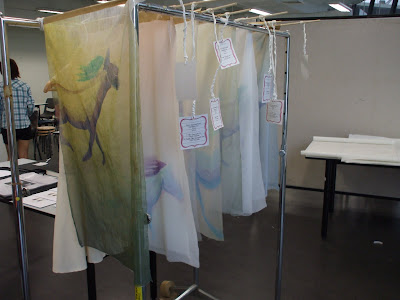



This is my blog which i have set up for school project task to record my creative journey. click on images to enlarge

 This is the chosen image I picked from the many pictures taken at Little India. It is a wooden horse puppet. I thought it was a good way to start my works based on horses, as these creatures are dominant animals throughout the history of man and also has an attractive value for children, as I intend to focus on kids wear.
This is the chosen image I picked from the many pictures taken at Little India. It is a wooden horse puppet. I thought it was a good way to start my works based on horses, as these creatures are dominant animals throughout the history of man and also has an attractive value for children, as I intend to focus on kids wear.







 I did some random paintings, line drawings. I tried very hard thinking about how I could change the plants in my drawing to make them look different and more contemporary.
I did some random paintings, line drawings. I tried very hard thinking about how I could change the plants in my drawing to make them look different and more contemporary.



















 In Week 3, we went to the Peranakan Museum. The museum tries to reflect the vibrancy of this group of mixed bloods. There was an emphasis on the strict rules the Peranakans set for themselves and their future generations. Elaborate practices and traditions to keep their culture on going and also to flaunt their wealth.
In Week 3, we went to the Peranakan Museum. The museum tries to reflect the vibrancy of this group of mixed bloods. There was an emphasis on the strict rules the Peranakans set for themselves and their future generations. Elaborate practices and traditions to keep their culture on going and also to flaunt their wealth.





 I tried again to cut the Door Gods, and consciously tried to modify it so it wouldn't look very Chinese. As I was doing it, I thought it looked a bit like the Kings of playing cards, and slightly medieval. I didn't think it was bad. I quite liked it but I needed some kind of assurance that this wasn't too Chinese looking.
I tried again to cut the Door Gods, and consciously tried to modify it so it wouldn't look very Chinese. As I was doing it, I thought it looked a bit like the Kings of playing cards, and slightly medieval. I didn't think it was bad. I quite liked it but I needed some kind of assurance that this wasn't too Chinese looking. "Eley Kishimoto is the brand of designers Mark Eley and Wakako Kishimoto. Mark is from Wales and Wakako is from Japan. They are based in London, and have been showing at LFW since 2001. I have chosen three collections to describe their design output based on speculation.
"Eley Kishimoto is the brand of designers Mark Eley and Wakako Kishimoto. Mark is from Wales and Wakako is from Japan. They are based in London, and have been showing at LFW since 2001. I have chosen three collections to describe their design output based on speculation.
 AW 0405 collection
AW 0405 collection


 SS 08
SS 08 From these three EK collections, I think there is an obvious fusion of a bit of Japanese art with Western aesthetics. Some influences of Art deco involved, and they are definitely inspired by everything they come to contact with every day, nothing philosophical.
From these three EK collections, I think there is an obvious fusion of a bit of Japanese art with Western aesthetics. Some influences of Art deco involved, and they are definitely inspired by everything they come to contact with every day, nothing philosophical. I like EK's cartoon-like use of colour and imagery, as well as the kind of girlish clothes they create. The pictures above show use of trompe loeil which is humourous and use of colours and imagery which i really admire.
I like EK's cartoon-like use of colour and imagery, as well as the kind of girlish clothes they create. The pictures above show use of trompe loeil which is humourous and use of colours and imagery which i really admire. I dislike these grandma-like silhoettes. They are stiff coats in patterns and colours I wouldn't immediately recognise as EK's work.
I dislike these grandma-like silhoettes. They are stiff coats in patterns and colours I wouldn't immediately recognise as EK's work. The picture on the left is from an EK-Ellese collaboration. It's got lots of penguins on it, and I think there is probably a parallel between the imagery I have created- the selection fo an animal to work on and repeating it.
The picture on the left is from an EK-Ellese collaboration. It's got lots of penguins on it, and I think there is probably a parallel between the imagery I have created- the selection fo an animal to work on and repeating it. I recently tried paper-cutting. The solid shapes and colours are definitely similar to some of EK's work.
I recently tried paper-cutting. The solid shapes and colours are definitely similar to some of EK's work. This EK dress is printed to look as if its got lots of ruffles. I am interested in creating 3D textures on 2D surfaces.
This EK dress is printed to look as if its got lots of ruffles. I am interested in creating 3D textures on 2D surfaces.